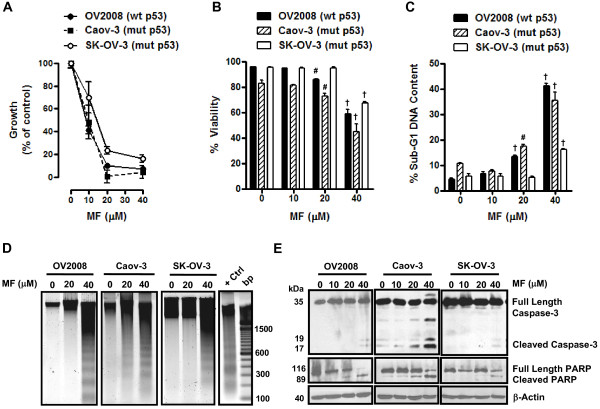Figure 5.
Effect of mifepristone on growth, viability, fragmentation of genomic DNA, and on expression of caspase-3 and of its downstream substrate poly (ADP) ribose polymerase (PARP) in OV2008, Caov-3, and SK-OV-3 cells. Cells were plated in equal number, allowed to attach to the plate surface for 24 h, and were then treated with either vehicle (DMSO) or the indicated doses of mifepristone in cell specific culture media for 72 h. Cells were then trypsinized, stained, and counted by microcapillary cytometry. The experiments were repeated at least three times in triplicates for each of the doses tested. A representative experiment is shown for each of the cell lines. (A) The total number of cells was recorded at the beginning of the experiment and after 3 days of treatment. The difference between number of cells in vehicle-treated controls at 0 h and after 3 days of culture was considered to be 100%. The growth of the treated groups is expressed as percentage of control. (B) This experiment was similar to that described in previous panel. Following the plating and treatment protocol, cells were collected after 72 h and viable cells were recorded by microcytometry using the Guava ViaCount application. Bars, mean ± SEM. #p < 0.01 and †p < 0.001 when compared to the control (0 μM mifepristone) for each cell line. (C) Following plating and treatment protocol, cells were collected after 72 h, fixed in 4% paraformaldehyde, stained with propidium iodide, and analyzed by cytometry using the Guava cell cycle application. Bars, mean ± SEM. #p < 0.01; †p < 0.001 when compared to 0 μM mifepristone. (D) Genomic DNA was isolated and separated by electrophoresis on a 2% agarose gel, impregnated with SYBR Gold nucleic acid stain, examined with an ultraviolet transilluminator, and photographed with the Amersham Typhoon fluorescence imaging system. A 100 base pair marker and a positive control (+ Ctrl) of fragmented DNA generated by treating OV2008 cells with cisplatin were run in parallel. (E) Cells were treated with the indicated concentrations of mifepristone for 72 h, whole cell proteins were isolated, electrophoresed, electrotransferred to a PVDF membrane, and exposed to anti-caspase-3 and anti-PARP antibodies. β-Actin was used as loading control.

